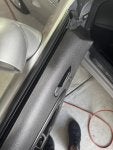It has been covered, but I've never seen pictures of the repair. I tried several plastic restoration products that did not work, actually did not change anything at all. I finally decided to use the heat gun.
I practiced on an old lawn chair until I was confident I wouldn't ruin anything.
Medium heat, if you have an adjustable gun, about 1.5 inches away and keep the heat gun moving, never staying on one spot too long. It is shiny when you are done, but that fades after the plastic cools.
Driver's door to show progress before and 1/2 done
I practiced on an old lawn chair until I was confident I wouldn't ruin anything.
Medium heat, if you have an adjustable gun, about 1.5 inches away and keep the heat gun moving, never staying on one spot too long. It is shiny when you are done, but that fades after the plastic cools.
Driver's door to show progress before and 1/2 done









